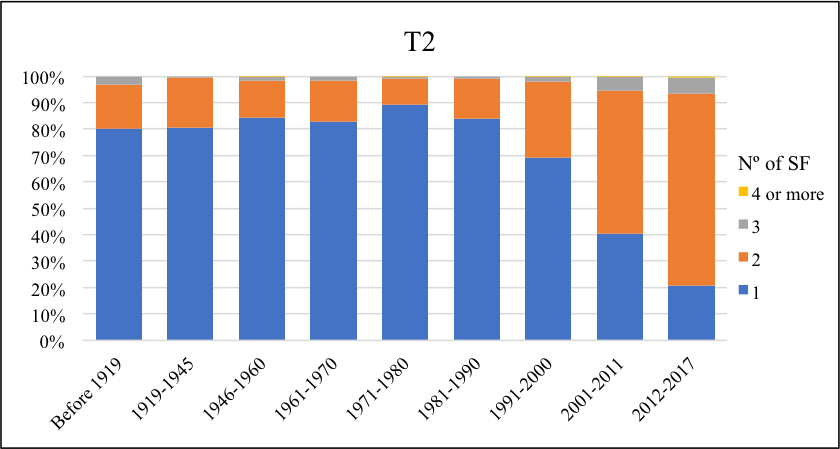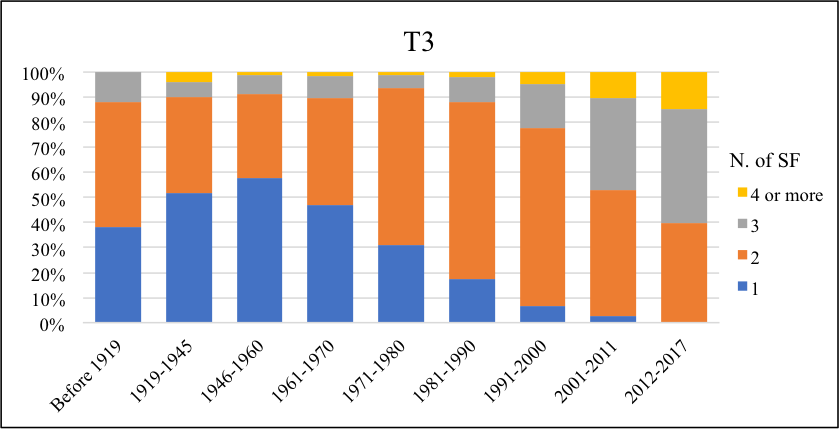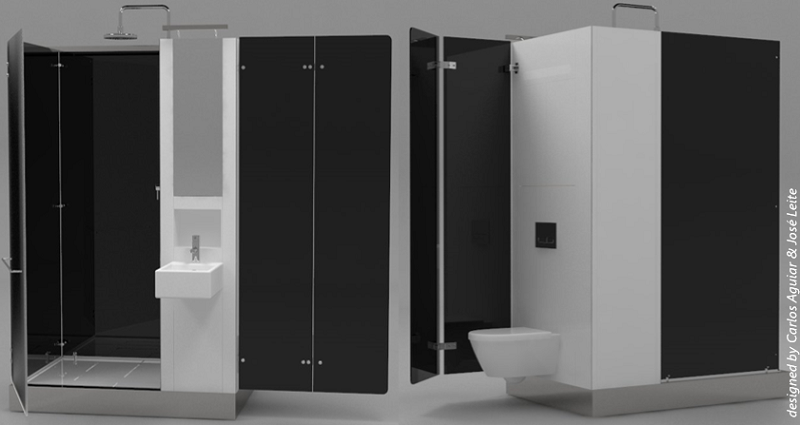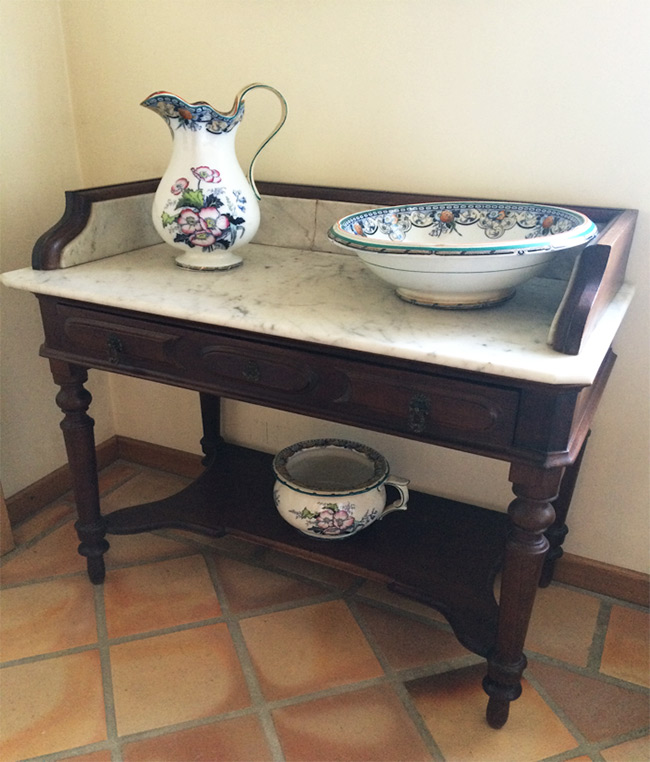
The long road of building rehabilitation and....water efficiency
Posted on: April 2018Inês Meireles
 |
Inês Meireles is Senior Lecture at the Department of Civil Engineering, University of Aveiro. Is responsible for courses on Hydraulics in the MSc. Degree in Civil Engineering at UA and is an integrated member of the RISCO Research Unit, developing research mainly on the areas of Sustainability in Construction and of Risks in the Built Environment. Ongoing projects includes: MoBaK - Modular Bathroom Kit. |
WatEf blog 2018 April 1st 2018
The long road of building rehabilitation and
....water efficiency
When I was a child, I used to observe all the antiques my parents had around the house. I particularly liked some objects that were, in fact, the bathroom of my great grandparents (Fig. 1) and never thought that the nowadays bathroom, that I always took for granted, could have been so different. Around the same time, I remember to find very awkward that my grandmother used to have a small “potty†close to her bed. However, between siblings, cousins and uncles, we were more than 18 people sleeping in my grandparent’s house for Christmas, and none of us ever questioned the existence of only one bathroom.
Figure 1 – My great grandparent’s bathroom (XIX century)
Evolution of sanitary facilities
It was about 6000 years ago that the first toilets and wastewater drainage systems appeared in ancient Mesopotamia, but it was only in the late 18th c. that the water closet (i.e., flush toilet) appeared for the first time (Antoniou et al., 2016). Around the late 1800s began also to be understood the connection between human wastes and diseases, and this might be the main reason for indoor toilets being still regarded as an indicator of housing quality.
In the European Union (Eurostat, 2015), reports show that nowadays 97.3% of the dwellings have at least one indoor flush toilet facility, with countries obtaining a coverage as high as 100% (Belgium, Luxembourg, the Netherlands, Sweden and the United Kingdom) and countries with values as low as 80.6% (Latvia and Lithuania) and 61.9% (Romania).
However, these statistics tell us nothing regarding the number of bathrooms per dwelling. Analysing a sample of 29 thousand dwellings presently for sale in Portugal, it is noticeable that the number of bathrooms per dwelling has been increasing in the last decades (Fig. 2).


Figure 2 - Number of sanitary facilities (SF) in a 2 bedroom (T2) and a 3 bedroom (T3) dwelling per period of construction in Portugal.
The market of rehabilitation
In accordance to the increment on the number of bathrooms per dwelling, other requirements such as aesthetical, functional, thermal or acoustic have also evolved.
With this evolution in mind, what if, in the European Union, everybody wanted to exchange to a brand new dwelling every 20 years to keep up with the requirements evolution? Assuming that, on average, each person would live in 4 dwellings during their lifetime, and considering an average occupancy of 2.5 persons per dwelling and a stabilized EU-28 population of 550 million inhabitants, 11 million new dwellings would have to be built every year to account for this demand. At the same time, equal number of dwellings would lay empty and would have to be demolished. According to the Eurostat (2018), in reality, only 10% of this number corresponded to new construction. In practice, renovation, refurbishment and rehabilitation contribute to adjusting the existing housing stock to this evolution.
Since nowadays buildings with more than 10-20 years do not fulfil the requirements of the users in terms of number of sanitary facilities, solutions are required to tackle this specific problem.
The concept of bathroom pod for rehabilitation… and water efficiency
The traditional solutions to increase the number of sanitary facilities in a dwelling are extensive, intrusive, time and cost consuming, produce high amounts of demolition waste, and sometimes are detrimental to the preservation of the building and corresponding image.
However, right in the 21th c. it would be expected that an intervention would be:
- less intrusive
- less time-consuming
- cost-effective
- environmentally efficient
Since the construction of a bathroom on site requires a lot of precautions regarding its installation, in particular due to the need to reconcile electrical and hydraulic networks with the construction of the walls, the search for alternatives, such as bathroom pods, has grown. The latter allow to optimize the process of building construction, namely in terms of execution time and cost. In addition, since bathroom pods are generally manufactured in industrial production lines, all stages of quality control, finishing and electrical and hydraulic networks are carried out in the factory, so that on-site errors and waste are minimized.
In order to set the targets for a new concept of modular bathroom pod, 52 bathroom pod manufacturers were analysed and it was concluded that:
- The majority of the bathroom pods are costumer tailored, based on a specific project, which forces the ordering of a significant number of units to enable a competitive unit price. This limits the use of in micro-scale rehabilitation/renovation, although 3 manufacturers present versatile bathroom pod models allowing to consider a specific setting of the devices at the time of acquisition. Target 1: To conceive a versatile bathroom pod model that can be assembled and disassembled in a vast number of settings.
- The majority of the bathroom pods require lifting equipment, due to weight and size restrictions, which may be a significant constraint in the context of building rehabilitation/renovation. However, 3 manufacturers have products that can be transported by parts. Target 2: To conceive a modular bathroom pod.
- All the studied bathroom pods are closed compartments. Target 3: To conceive a bathroom pod partially open, which can fit into spaces of smaller dimensions than the minimum area required to install the other bathroom pods without reducing user comfort.
- All the studied bathroom pods incorporate hydraulic, sanitary and electrical installations, as well as sanitary devices. Target 4: To conceive a bathroom pod that incorporates hydraulic, sanitary and electrical installations, along with a toilet, a washbasin and a shower.
- Part of the studied bathroom pods cannot be distinguished from a traditional bathroom after their assembling and part lay visible their modular aesthetics. Target 5: To conceive a bathroom pod with high standards of aesthetics and which transmits a sense of lightness and modernity.
- None of the studied bathroom pods referred specifically to water efficiency. Target 6: To conceive a bathroom pod that reflects water efficiency concern in its use: a) has water efficient appliances; b) is prepared to receive rain water, waste water or any other source water to flush the cistern; c) is prepared to transport gray water (shower and washbasin) separately from black water (toilet) to allow for their reuse.
The MoBaK project, initiated in 2016, combined the competences of OLI, Italbox and the University of Aveiro with the aim of developing an innovative bathroom pod concept (Fig. 3) complying with the set of targets listed. You can give your feedback on this new bathroom pod concept at https://goo.gl/forms/vOZh8961ImnfuGbA3.

Figure 3 - New concept of bathroom pod adapted to rehabilitation.
In the broader concept of sustainability, it is expected that the construction sector in Europe will resort to more pre-fabrication and that the rehabilitation keeps on gaining relevance. As such, the new modular bathroom pod is being developed with a holistic sustainability approach, considering the financial (life-cycle cost), environmental (life-cycle assessment) and social dimensions. The concept involves the maximization of reusable/recyclable materials, the minimization of waste production and water consumption, while providing an easy to transport, assemble/disassemble compact and flexible product. The flexibility is not limited to the spatial configuration, but is also considered in terms of compatibility with novel technologies (e.g., rainwater use).
Some further info about this study:
R&TD Co-Promotion Project “MoBaK – Modular Bathroom Kit†by the companies OLI, Sistemas Sanitários S.A. and Italbox, the Water Protect Lda and the University of Aveiro, with Inovadomus and Lislei as partners, supported by Portugal and the European Union through the FEDER, COMPETE 2020 and Centro 2020, under Portugal 2020, 2016-2019 (http://mobak.web.ua.pt).
References:
Antoniou G.P., De Feo G., Fardin F., Tamburrino A., Khan S., Tie F., Reklaityle I., Kanetaki E., Zheng X.Y., Mays L.W. and Angelakis A.N. (2016). Evolution of toilets worldwide through the Millennia. Sustainability, 8(779).
Eurostat (2015). People in the EU - statistics on housing conditions. Eurostat, Available at: http://ec.europa.eu/eurostat/statistics-explained/index.php/People_in_the_EU_%E2%80%93_statistics_on_housing_conditions, [Accessed 15/07/2017].
Eurostat (2018). EU Buildings database. Eurostat, Available at: https://ec.europa.eu/energy/en/eu-buildings-database [Accessed 24/03/2018].




